Rooftop Rainwater harvesting (RRWH)
An easy step-by-step guide to install rooftop rainwater harvesting (RRWH) at your location.
- Solution for government buildings, commercial buildings, factories, housing societies, educational institutions, individual houses etc.
Water scarcity, pollution in water bodies, access to clean drinking water, threat to water dependent ecology, erratic rainfall and climate change are pressing issues around water management. Several government schemes and policies, non governmental organisations and private companies work to address these water issues.
Rain water harvesting is the technique of collection, filtration and storage of rainwater at surface or in subsurface aquifers, before it is lost as surface run-off, such that the collected water can be harvested in the time of need.
You as individual citizens, colony members, school representatives can harvest rainwater falling in your premises,. will bring the major benefits of:
(i) Maintain level of groundwater in borewell, and prevent the threat of borewell drying up which otherwise leads to drilling another borewell
(ii) Maintain or reduce TDS level of water and reduce your water purification needs, especially RO treatment which is installed in most urban households. RO creates a lot of reject water in its process, RWH will reduce dependency on RO treatment.
You also contribute to water conservation.
In this article you can find useful resources to install a roof rainwater harvesting system at your place.
Where to install rooftop rainwater harvesting system?
RRWHS can be installed in any building having a roof area, and space to store rainwater in a tank or recharge your own borewell as groundwater. Government offices, institutions, industries, apartments buildings, bungalows, etc., can install rainwater harvesting systems. Schools can also be a great setting for installing rainwater harvesting systems, as it will meet water needs for students’ and staff, and also inculcate practical learning about water conservation and environment among students.
Types of rainwater harvesting:
Storage:
One way of harvesting rainwater is to store it in a tank on the ground, after filtering it. Depending on water usage and rainfall availability, a large portion of a year’s water needs can be met by this stored rainwater.
Recharge:
Often, space to make storage tanks for rainwater, is inadequate, and in such cases it can be used to recharge the groundwater.In most cases, a functioning borewell itself can be recharged with rainwater after filtering. In some other cases, a defunct borewell (functioning earlier but now not functional), can be used for recharge. If there is no current borewell, a recharge borewell can be made, after studying the aquifer/groundwater characteristics of the location.
Combination:
RRWHS is often implemented as a combination of storage and recharge. The rainwater, after filtering, is led to an existing storage tank on surface. Overflow from the tank, not uncommon in monsoon, is led to recharge the borewell.
The overall RRWH System is depicted in the diagram below:
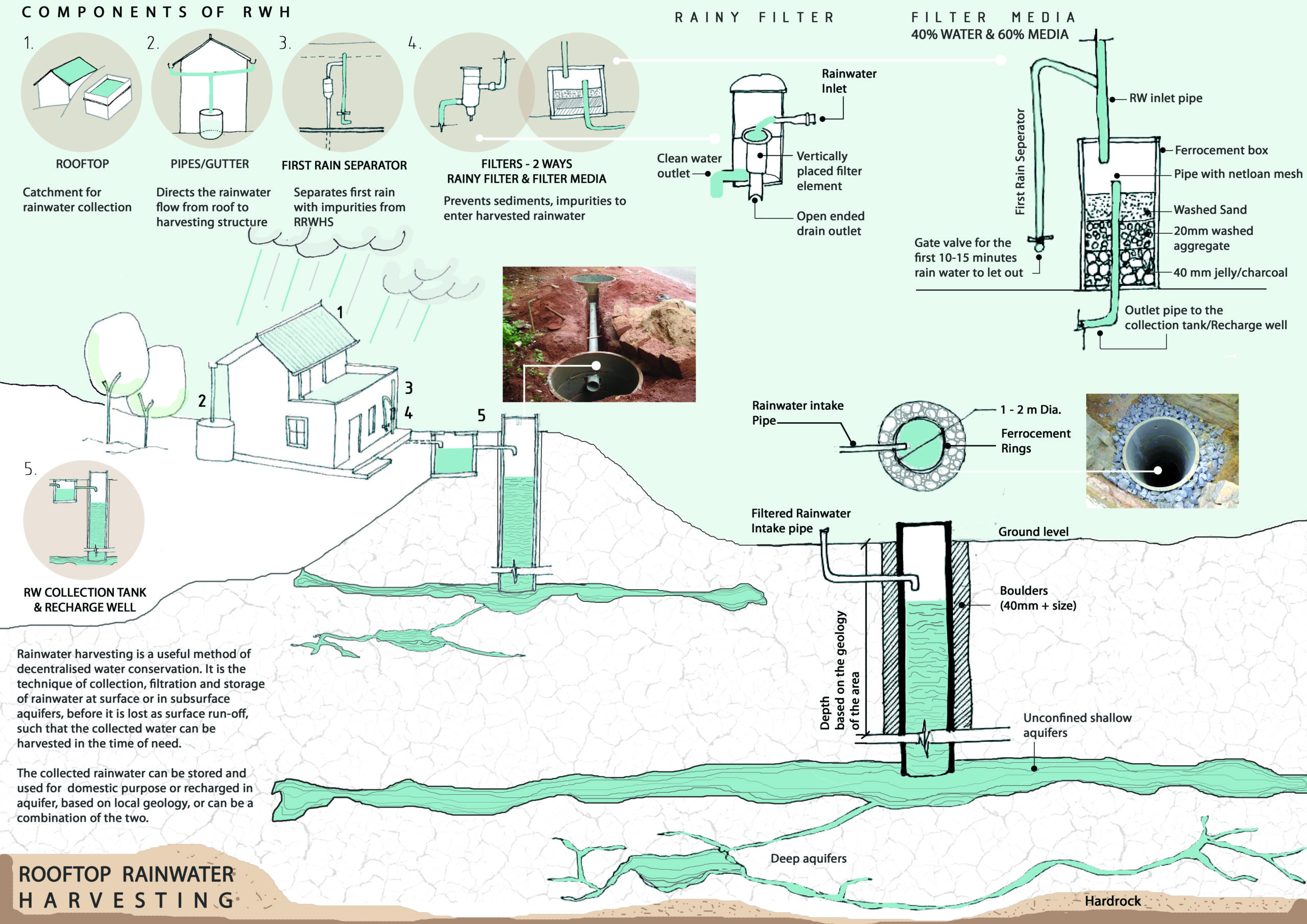
Each Components of a rooftop rainwater harvesting system is explained below:
- Roof:
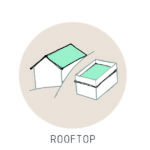 The roof of any building is an important catchment area, which is a surface on which rainwater falls and it can be directed to storage or for shallow aquifer recharge. The roof can be sloping or flat, and it is important to check that the finishing materials or paint used on the roof is non-toxic and does not contain mercury. Before the first rains, it is important to clean the roof thoroughly to avoid dirt and other impurities from mixing with rainwater.
The roof of any building is an important catchment area, which is a surface on which rainwater falls and it can be directed to storage or for shallow aquifer recharge. The roof can be sloping or flat, and it is important to check that the finishing materials or paint used on the roof is non-toxic and does not contain mercury. Before the first rains, it is important to clean the roof thoroughly to avoid dirt and other impurities from mixing with rainwater. - Pipes: Rainwater can be brought down from the roof through pipes. The size of pipes can be decided as per
 rainfall intensity and roof area. For aesthetic purposes, sometimes people use rain chains instead of pipes. These chains direct the water flow from roof to floor, reduce splashing and create a good visual as water flowers down.
rainfall intensity and roof area. For aesthetic purposes, sometimes people use rain chains instead of pipes. These chains direct the water flow from roof to floor, reduce splashing and create a good visual as water flowers down. - First rain separator: The first rain of the monsoon season is not stored because the dirt and organic matter mixes with
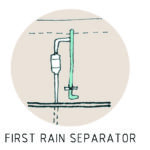 water and such water can create contamination in storage tank. So the first rain separator removes this water, and subsequent rainwater can be collected.
water and such water can create contamination in storage tank. So the first rain separator removes this water, and subsequent rainwater can be collected. - Filter system: A filter is needed to prevent stones, leaves, dust and other particles from entering storage tanks or recharge pits. It can be (i) ready filter cartridge available from several manufacturers – to be mounted a
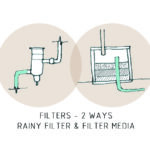 few feet above ground on the pipeline bringing water from the roof or (ii) a set of filter chambers usually constructed underground with input from the roof water pipe and output to the storage of borewell.
few feet above ground on the pipeline bringing water from the roof or (ii) a set of filter chambers usually constructed underground with input from the roof water pipe and output to the storage of borewell. 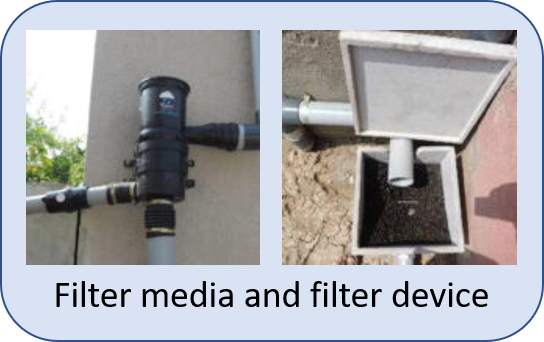
- Storage: The capacity of a storage tank can be designed based on space availability, needs and usage. If the water is to be used for drinking purposes, the tank can be smaller than if the intended use is for non-drinking purposes.
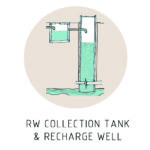
- Recharge and excess outlet: Once the storage tank is filled, the overflow can be directed to recharge groundwater.
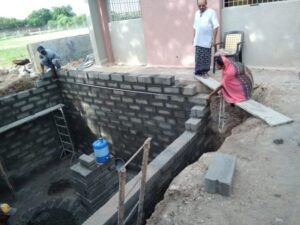
Rainwater harvesting storage tanks
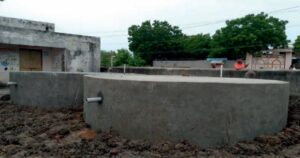
Steps to design a rainwater harvesting structure:
- Calculating supply (rainwater availability):
A = Average annual rainfall of your region.
B = Roof area of your building
C = Runoff coefficient (Runoff coefficient depends on roof surface material – generally taken as 0.7 to 0.8 for concrete roofs)
Available annual rainfall = A * B * C
- Calculating demand of building users (for RWH storage):
X = 135 litres of water used per capita per day (standard for calculation)
Y = Number of residents/users
Z = 30 days in a month (average)
Monthly water demand of unit = X * Y * Z
- For storage type:
- The size of the tank can be designed as per space availability, water demand and economic reasons. It may happen that all rainwater from the roof cannot be stored in tanks for use. During high intensity rainfall events, the tank may get filled sooner and the usage rate will remain the same, so the excess water can be diverted to recharge groundwater.
- Existing pipeline systems may have to be modified to take the roof rainwater to the tank through a filter system.
- Estimate the costing based on pipeline modifications, filter systems, storage structure and initiate execution.
- For recharge or storage+recharge option:
- The overflow from the RWH storage tank can be directed to recharge wells or recharge borewells. So accurate calculations for tank capacity and overflow management may not be necessary.
- Existing pipeline systems may have to be modified to take the roof rainwater to the tank through a filter system, and overflow pipelines to be directed towards recharge structure.
- Estimate the costing based on pipeline modifications, filter systems, recharge structure and initiate execution.
- Maintenance
- Check the terrace areas for any major spillage of oil, chemicals or garbage and clean it particularly at the beginning of the monsoon season and then every few months.
- Using the first rain separator (FRS), water from initial two rain showers should be drained off. Then close the cap of the FRS for subsequent rains, so the water flows from roof through the filter to the tank or recharge as per design.
- Lid of the storage tank should be kept closed all the time, and water stored inside should not be exposed to sunlight.
- If rainwater is being stored and used, then regular water quality tests will have to be done to ensure drinking water standards, and perform treatment if necessary.
- Storage tank should be cleaned once a year especially before the monsoon season.
- Filter media aggregates or filter cartridges should be cleaned as per their maintenance routine.
- Stored rainwater can be disinfected by chlorination or boiling water before use.
Rainwater harvesting is a useful method of decentralised water conservation. It is the technique of collection, filtration and storage of rainwater at surface or in subsurface aquifers, before it is lost as surface run-off, such that the collected water can be harvested in the time of need.
Abbreviations:
TDS Total dissolved solids
RO Reverse Osmosis
RWH Rainwater harvesting
RRWHS Rooftop rainwater harvesting system
FRS First rain separator
Interested in adopting Roof Rain water harvesting system for your school, society, house or office / commercial building?
If you are keen to adopt the RRWH and improve your own water source as well contribute to water conservation, and if you need guidance or any information, feel free to contact us at info@winfoundations.org
WIN Foundation provides this guidance at no cost.


